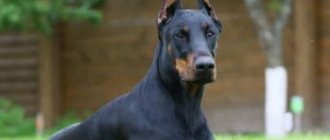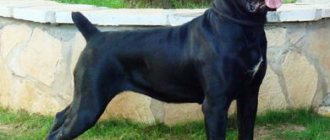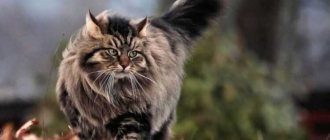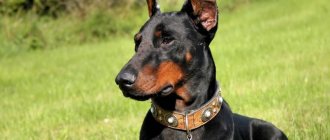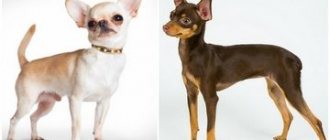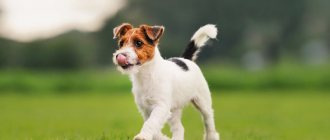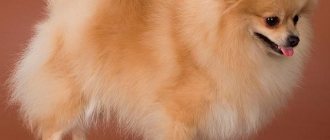The Doberman is one of the most suitable breeds for protection, sports, detection work and games. Dogs are distinguished by such qualities as:
- energetic temperament - they do not sit still, they are constantly in search of adventure;
- vigilance – with such a security guard you don’t have to worry about safety;
- obedience and hard work - working with him will bring a lot of pleasure;
- inexhaustible enthusiasm - you will have to make a lot of effort to direct their energy in the right direction;
- the ability to protect their territory and members of the “pack” - while they can be dangerous to others;
- intelligence – the intellectual abilities of representatives of the breed are at a high level;
- absence of diseases typical for service breeds - the breed has maintained good health and has an exterior that has not been disfigured by humans.
Dobermans belong to the golden fund of the best guard breeds in the world. However, heredity plays a large role in the character of an animal. Proper upbringing can do a lot, but not everything. A genetically deformed psyche cannot be corrected. If you decide to get a purebred pet, choose a breeder responsibly.
Characteristics of the Doberman dog breed: advantages and disadvantages
Male:
Bitch:
Price:
Life expectancy: 10–12 years, sometimes up to 16 years. |
Is it difficult to care for a Doberman? | Active walking, proper diet and regular dental examinations are all he needs. There are difficulties with upbringing, which can be overcome by a confident, decisive, but restrained owner. |
Where is it better for a Doberman to live: in an apartment or a house? | It takes root well both in the house and in the apartment. The main thing is to find something for him to do: he can be a watchman, a companion for children's games. |
Can it be kept in an enclosure? | Not suitable for aviaries. He is too attached to his owner and requires constant contact with him. And a short-haired dog cannot sleep in the snow like a husky. If you decide to build an enclosure, then only a warm one. |
How often should you bathe? | It is enough to carry out water procedures several times a year. |
Is it necessary to crop Dobermans' ears and tails? | Whether or not to crop the ears and tail is the choice of the dog owner. Today the standard allows both options. |
Do Doberman Pinschers shed? How to care for wool? | Even short-haired breeds shed. The wool is cleaned with rubber brushes and wiped with a damp terry towel. Train your pet to use a vacuum cleaner, this will make cleaning easier. |
Can I buy for a child? | The four-legged friend is good with children, but its owner must be an adult. Children from the age of 14 can engage in education. |
Bitch or male? Whom to choose? | If you do not have experience raising dogs of serious breeds, get a female. They rarely make attempts to gain leadership in the house, they are more flexible and less hot-tempered. |
In which family does the breed take root better? | The breed is universal - suitable for single people, couples and families with children. |
Who copes with parenting easier: men or women? | The gender of the owner is not as important as his temperament. The Doberman is not suitable for infantile people with an overly soft character. |
How often should you go for a walk? | This is an active dog that needs daily exercise. Walking should be active. Let him run freely for at least an hour and at least 10 minutes a day off-leash. |
Do you need special clothing? | In our climate, Dobermans freeze in winter. They need warm blankets for walks in the cold. |
Can it be kept with other animals? | The pet needs socialization. But with due patience on the part of the owners, he gets along well with his fellow tribesmen and cats. |
Advantages of the breed
- Versatility: can be a guard, a bloodhound, a guide for the blind, a companion.
- With proper training, a dog does not show aggression unless necessary.
- Doberman falls in love with his owner. What the owner requires of him is sacred to him.
- The dog is very observant. If you allow the slightest weakness, he will take advantage of it.
- The behavior of the pet depends on the owner and the methods of education he has chosen.
- This dog has a well-developed search instinct. A four-legged friend can find anything.
- He is smart and smart. Studying and working are the dog’s favorite activities.
- An active and energetic pet will be happy to accompany you while jogging, cycling, and outdoor games.
- The breed is recognized as highly intelligent. Its representatives have a sense of self-esteem and a high degree of responsibility.
- Pets are cunning and have excellent memory. They respond well to training.
Flaws
- The pet is wayward. This trait manifests itself from an early age. A puppy should be taught discipline as early as possible.
- For busy people, the disadvantage may be the need for constant communication. However, this is fixable, because dogs behave calmer when paired.
- With improper upbringing, a tendency towards aggression may appear.
- Suitable only for strong and strong-willed people; a phlegmatic Doberman may not perceive him as a leader.
- It reacts more painfully than other breeds to a change of owner.
- He perceives new family members with caution. Problems may arise when the baby arrives.
- He loves to sleep and is not averse to choosing the owner’s sofa or bed for this. If you think that such behavior is unacceptable for a four-legged family member, do not allow him to do this and severely punish him for disobedience.
Doberman: dog character, behavior
There are many rumors and legends about dogs of this breed. Most of them have no basis. In fact, the Doberman is moderately aggressive and does not like to bite, as is often shown in films. Biting dogs do occur, but this is due to improper selection or errors in education.
Initially, the Doberman is a balanced creature. If it falls into capable hands, it reveals all its best qualities.
And vice versa, the pet will fool a not very smart owner. In such cases, the dog becomes the leader in the family and may show unmotivated aggression.
This breed is not for everyone. It can create inconvenience. A bored Doberman, especially a young one, can damage property in the house, organize concerts with howling and other performances. And all with a single goal - to attract attention. But find something to do for him, and you will see what a wise and strong protector your Doberman will become. The characteristics of the breed confirm this.
Behavior at home
Many owners say that he is able to guess thoughts. And the pet really knows how to amaze. Especially unique abilities to distinguish between good and evil on an intuitive level, as well as speed of reaction to what is happening and boundless devotion. A Doberman playing with children is a familiar sight for owners of the breed.
If there is no mutual understanding in the house, the animal will grow up hot-tempered and unbalanced.
He is sensitive to the microclimate in the house, quickly reacts to quarrels between family members and the mood of the owner. He really doesn't like it if people don't pay attention to him. After all, a handsome, stately man is a social and intellectual being.
Behavior on the street
During a walk, the four-legged friend always keeps the owner in sight. He is ready to come to his aid at the slightest danger. Untrained dogs or individuals with unstable psyches may show aggression towards moving objects. This is not the norm.
Aggression in itself is not a defect. This is a normal quality that a dog needs. It only becomes a problem when it is excessive.
A responsible breeder will exclude such individuals from breeding. And an experienced owner corrects it with education.
Attitude towards strangers, protection of the owner and home
The Doberman is a dog for protection, not for attack. If you socialize your puppy from an early age, accustoming him to the presence of strangers and animals nearby, the pet will calmly react to them in adulthood.
But a hot temper can manifest itself when meeting with fellow tribesmen: the dog sometimes gets involved in fights, in which, as a rule, he wins. He will not wag his tail at the sight of his owner's friends. Usually the pet is indifferent and cold towards everyone except members of the owner's family.
Watch a video about the breed
Owning a Doberman is a serious step, which must be taken with a full understanding of the responsibility that rests with you for the life and health of the animal, responsibility for its wayward behavior, proper upbringing and training.
If you do everything correctly, approach all issues wisely, you will get a faithful and obedient friend who will live happily ever after in your family. In another case, you can get an aggressive animal, which can be dangerous both for the owner (whom it does not consider the owner) and for society.
Photo of Doberman
Care and maintenance
Unlike education, daily care of a pet does not cause difficulties even for lazy owners. A stately Doberman will feel great both in an apartment and in a country house. Care and maintenance in the enclosure is allowed if it is possible to make it insulated. And communicate with him as often as possible.
Without a warm shelter, the dog will simply freeze, and without communication it will become dull and inadequate.
Grooming
The pet requires minimal care - wipe it with a towel daily to remove loose hairs. Many owners take care of the fur during shedding using a vacuum cleaner. It's fast and convenient. But the baby needs to be accustomed to the procedure as early as possible, otherwise the adult dog will be afraid of the loud howling of the equipment.
Nail care
After a walk, wipe the paws with a damp cloth. Claws are usually not trimmed in the summer. If your four-legged pupil walks a lot on asphalt or other hard surfaces, he will grind them himself better than any tools.
In winter, when dogs walk less, and even on soft snow, you need to keep an eye on their claws and, if necessary, trim off the keratinized tissue with special tweezers. Usually this is done no more than 1-2 times a month. You need to trim the claws carefully so as not to catch the “living” part of the claw, which is replete with nerve endings and blood vessels.
Teeth
Beautiful teeth are the calling card of a stately guard. The mouth must be inspected daily. Small plaque on the teeth is removed with a cotton swab and dog tooth powder or paste. Pieces of stuck bones or wood chips are removed using tweezers.
Periodically, the teeth are brushed with a special dog toothbrush and treated with anti-plaque spray. Please note that the spray does not remove already formed tartar. It can be removed at a veterinary clinic.
Ear care
In our country, Dobermans with cropped ears are more common. Erect ears are better ventilated, but dust, dirt, and water easily get into them. Ear examinations are usually performed every 2-3 weeks. During the procedure, the auricle is cleaned with gauze, bandage or cotton swabs.
Do not rinse your ears with hydrogen peroxide. For hygienic cleaning, ear drops for dogs are used. They are sold in veterinary pharmacies. During the procedure, the ear stick is inserted only to the depth of the vertical canal, that is, within visibility. Otherwise, you risk damaging your eardrum.
Eyes
Every morning you need to clean the corners of your pet's eyes from the secretions that accumulated during sleep with a piece of bandage. Cotton wool is not suitable for these purposes. Its villi can irritate the mucous membrane.
If the discharge becomes heavy or has a greenish color, dust may have gotten into your eyes. In this case, apply pediatric eye drops to your eyes. But if there is no improvement, consult a doctor. Conjunctivitis, which seems harmless at first glance, can be a symptom of such a dangerous disease as the plague.
Intimate hygiene
Once a week you need to examine the genitals of pets of both sexes. If purulent or mucous discharge appears in a male dog, the male's preputial sac is washed with a solution of chlorhexidine digluconate. The drug can be purchased at a regular pharmacy. It is also available in spray form.
An easy-to-use spray is used to treat the genitals of animals after swimming in open water. But if female dogs have discharge between heats, consult a doctor. They can be symptoms of dangerous diseases.
Vaccinations
Vaccination of animals does not provide a 100% guarantee that the animal will not get sick. But it significantly reduces this risk. Dobermans are vaccinated against:
- plague;
- adenoviral hepatitis;
- parvovirus infection;
- parainfluenza;
- leptospirosis;
- rabies.
As a rule, complex vaccines are used. Only completely healthy dogs can be vaccinated. Before administering the serum, dogs are dewormed (at least 10 days in advance).
The first vaccination is given to puppies twice: at 1.5–2.5 months and at 2–3 months. Then, 3 weeks after the first vaccination, repeated vaccination is carried out. Adult Dobermans are vaccinated once a year.
How to name a pet
After the puppy has been purchased, it is important to decide on its name. What do you call a Doberman? Often called nicknames today will not surprise anyone. Therefore, many dog breeders try to distinguish their pet from the rest with the help of a nickname. They choose original and rare names.
The selection of nicknames, of course, is carried out on the basis of gender. So, the following names are suitable for a boy: Black, Demon, Visuvius, Conan, Coal, Ulan, Centurion, Hassan, Figaro, etc. For girls there are also unusual names: Goldie, Venus, Bagheera, Star, Indy, Luna, Steffi , Justina, etc.
Moreover, the above nicknames reflect both the color of the animal and its character. The main thing is that the nickname is original, but does not cause unpleasant associations. You can also choose names with meaning. But you should be careful here, since such nicknames are usually taken from foreign languages.
Therefore, even a word that sounds euphonious to us in translation can have a completely unexpected meaning. In this case, it is best for the name to reflect either the dog's color or a specific character trait. Knowing how to choose the right Doberman puppy for yourself, you can raise a true friend for yourself and your children, as well as a true protector.
Ear and tail docking: what you need to know about it
In our country, docking is not prohibited. But many countries abandoned this operation. Dogs with cropped ears and tails cannot take part in exhibitions in these countries. However, many are more accustomed to seeing the Doberman with a short tail, with ears on the top of its head.
At local shows you can see dogs with floppy and high-protruding ears, with and without tails. Today, undocked ears are recognized as equivalent to cropped ears. But in the homeland of the breed, in Germany, Dobermans’ ears are no longer cropped. In this case, the choice remains with the owners and the breeder. Only you can decide what your Doberman will be like. Ear cropping is a cosmetic procedure. We carry it out in veterinary clinics.
For Dobermans, the operation is combined with ear placement. The procedure is recommended to be carried out at 3 months of age, usually after the 2nd vaccination. The operation is performed under anesthesia.
When cut, the length of the ear should be at least 3/5 of its original length. To do this, use special patterns and clamps to fix them. After cutting off part of the auricle, a cotton-gauze pad is placed on the back of the head. The ears are placed in it in a straightened form. Strengthen everything with a bandage. After 3-4 hours, the bandage is removed.
Then a special “crown” is constructed. The dog wears it until the ears heal. The structure is made of wire. His goal is to put ears on. The ears are fixed using an adhesive plaster and bandage.
Color
Initially, the breed standard, approved in 1899, recognized exclusively black color. In 1901, the Association of Dog Trainers included representatives of these brown dogs in its register.
In accordance with the established characteristics of the breed, there can be two types of Dobermans based on coat color:
- black;
- brown.
With the exception of Britain and the USA, only these two coat colors are recognized in all countries.
The color of both varieties of this breed has a remarkable feature - the presence of tan or red tan.
In both the black Doberman and its brown relative, you can see such tan marks in the eyelid area, on the cheekbones, and in the chest area between the forelimbs. Similarly, such markings are visible inside the ears, near the mouth and under the tail. There are also such tan marks on the limbs of the hind and front legs.
Black Dobermans
In frequently seen photos of a Doberman, you can usually see a dog of this breed with exactly this color. Such animals with their dark coat color make an indelible impression, emphasized by the contrast of color of almost the entire body and local lightened tan marks in certain areas.
This color is considered the main color for these dogs.
However, some puppies are born entirely of this color, with barely noticeable darkened tan marks. Such dogs are not allowed to participate in exhibitions. Likewise, they are not used for purebred breeding and production of puppies. But in service dog breeding, such pets bring benefits no less than their relatives with the appropriate coat color.
Melanism - a uniform color - is considered a defect; such cases are rare.
The advantage of dogs of this breed with this color is their bright red tan, which contrastsly emphasizes individual elements of the exterior. Darkening or too light a shade is considered an anomaly.
The classification of colors with this coat color suggests two options:
- anthracite - with shiny wool;
- deep dark - with a slight reddish tint, noticeable in the sun's rays.
Such features are dictated by the action of dominant genes. In the first case, this is the result of purebred genetics. In the second, it is a consequence of greater activity of genes that contain a red tint.
Brown Dobermans
Dog breeders consider the advantage of the brown color to be its visual appeal. Shades from red to dark chocolate give the dog softness, while significantly enlarging the body when visually assessed. Dogs' eyes are brown, with a slightly light tint. The color of the nose is light brown, uniform.
Brown Doberman
In addition to these colors, there are varieties of dogs with non-standard coat colors. These include albinos (usually white), who are not recognized by dog handlers in any country in the world. In addition, as a result of genetic disorders, even parents of the same color may produce offspring of isabella, blue, or red shades. All of these colors of Dobermans are considered abnormal, and such dogs are not allowed to breed with purebreds of a standard color or to participate in exhibitions.
What to feed
The shape of a pet's ears is not the only dilemma that owners of pedigree dogs face. They also have to choose what to feed the Doberman. This can be dry food or natural feeding. You can contact the breeder for help. Look at his dogs. If you are happy with their appearance, you can feed them the same food. However, the choice is yours.
What you definitely shouldn’t do is mix dry food with natural food. Such a diet can harm the digestive system.
Puppy diet
The puppy you just bought should be fed according to the breeder's instructions. He experiences stress when changing his place of residence. During this period, changing your diet can lead to stomach upset.
When using dry food, follow the recommendations on the packaging. When choosing “natural” food, the emphasis is on meat. From 2.5 weeks it is given in scraped form, from 3 months of age it is cut into pieces of 1.25 cm. Raw beef and veal are suitable for babies. At 3 months they give lamb.
Daily meat intake for puppies depending on age:
- 1 month – 50 g;
- 2 months – 100 g;
- 3 months – 300 g;
- 4 months – 400 g;
- 5 months – 500 g.
Trimes, hearts, lungs and chicken stomachs are taken from offal. Porridge, vegetables, cheese, crackers can only be an addition to a meat dish. Puppies are given cottage cheese and fermented milk products. Among the cereals, preference is given to buckwheat, rice, oatmeal, and millet. During the period when the ears are set, puppies are given calcium, which is necessary for the formation of cartilage.
Adult dog diet
Feeding an adult Doberman with natural food is a difficult and expensive task. Dogs are recommended to eat a day:
- meat products or fish – 600–800 g;
- porridge – 500–800 g;
- vegetables – 200 g;
- cottage cheese – up to 300 g;
- fermented milk products – up to 200 g.
This is the minimum necessary for animals. The food should be thick. Soups are not suitable for Dobermans. With significant physical exertion, during active training, the portion of meat is increased to 1200–1400 g. This also applies to pregnant and lactating bitches.
The following foods are not suitable for Dobermans:
- smoked, salted, fatty meat;
- pork and chicken bones;
- sausage, frankfurters, store-bought stews, dumplings;
- food from the owner's table;
- pasta (they are poorly digested and cause fermentation in the stomach);
- fresh pastries, bread in large quantities (but sometimes you can eat crackers);
- peas, corn, raw dough;
- semolina porridge (it provokes obesity and causes “reverse peristalsis” in some dogs);
- potatoes in any form.
Adult dogs are recommended to be fed 2 times a day. Animals do not need a varied menu. They calmly eat the same thing all their lives.
Think again
Before you go to choose a Doberman puppy, weigh the pros and cons. Discuss with your family the possible difficulties, who will walk the dog, what you will feed it, and whether you can provide the right amount of exercise for your pet. If the decision has already been made finally and irrevocably, and no one can convince you otherwise, decide what exactly you want from the dog. If in other breeds you can compromise when choosing cheaper kennels, then with Doberman puppies, it is better not to hope for a discount.
Happy mother with cheerful children
It's not even a question of saving, it all depends on the genetic qualities of the puppy. If, for example, experienced breeders can easily tell and even show you all the necessary documents about the absence of an aggressive gene in distant relatives of a puppy, then popular sites for selling animals will not be able to do this. We are talking not only about the most famous sites; as a rule, even in nurseries you can run into unscrupulous breeders.
Training and education
A Doberman puppy resembles pliable plasticine. Thanks to his natural ingenuity and athletic build, he is easily trained and can master any service.
In urban conditions, the puppy must learn the following commands:
- "to me";
- "stand";
- "near";
- "ugh".
The puppy must know what he can do in the house and what he cannot do. Misdeeds are punished. Babies have short memories. Punishment must follow immediately after the offense. Adult dogs remember much longer. They can be punished after some time. But between the punishment and the offense there should be no feeding or walking.
If possible, you need to train your Doberman in a dog training area. There, experts will suggest important points and point out mistakes in upbringing.
Smart Dobermans learn basic commands faster than other breeds. Training must be provided by the owner. To gain authority, you need to ensure that commands are followed. Otherwise, the cunning Doberman will begin to come up with tricks.
Pedagogical difficulties
The Doberman is rightfully considered an ideal service dog .
Legends are formed about the diligence, obedience and service zeal of the breed. But to consider the breed easy to train would be a serious mistake. One of the necessary selection parameters for the “gendarme dog” was the ability to make independent decisions and work “alone.” Independence implies the highest intelligence: all Dobermans are amazingly smart. Along with intelligence, the owner receives terrible stubbornness and willfulness. Dobermans perfectly recognize the strongest in the family hierarchy, easily integrate into the system of relationships and obey only the leader. The dog will, of course, protect the owner’s children, but by definition will not obey the child’s commands.
Dobermans get sick from “lying on their sides” on the sofa; boredom and monotony of the situation drives the dogs into the wildest depression. Active and active dogs need constant movement and busyness. Otherwise, Dobermans simply “fly off the rails.”
Finding a use for service talents, giving an opportunity to splash out energy and enthusiasm, creating a feeling of employment, necessity and usefulness is the main task of the Doberman owner.
Health, tendency to disease
The breed is quite healthy. However, it also has weaknesses. More than 5% of Dobermans have heart problems. Dogs suffer from a dilated form of cardiomyopathy. This is a congenital disease. It appears in both puppies and adult dogs. Most often in 7–8 year old males.
In the early stages there are virtually no symptoms. Then shortness of breath, weakness, and fainting appear. At this stage, the animal can no longer be helped. Therefore, an annual examination by a veterinarian to detect the disease is recommended.
Like other large breeds, Dobermans may suffer from:
- diseases of the musculoskeletal system (dysplasia of the hip and elbow joints, inflammation of the intervertebral discs);
- bloating (largely depends on the diet and regime of the animal);
- eye diseases (cataracts, retinal atrophy, entropion);
- skin diseases (seborrhea, allergic dermatitis, others);
- cancer and diabetes (develops with age).
The list turned out to be impressive, but this whole bouquet rarely appears provided that there is competent selection and conscientious breeding.
Choosing and caring for a puppy
You can bring a puppy home no earlier than he is a month old, preferably 45 days. It would be good if during the selection process you have the opportunity to consult with an experienced dog breeder who is familiar with the characteristics and standards of the breed.
When choosing a puppy, they are guided by the following criteria:
- baby's health;
- appearance and grooming;
- no visible health problems;
- activity in behavior.
Sometimes an albino puppy appears in the litter. You can't take it. The fact is that such a baby has serious health problems. Albinos are not healthy.
Breed standards
| Usage | Police, security, protection dog, companion. |
| Appearance | The dog is above average height, strong build, muscular and elegant. |
| Temperament, behavior | Brave and decisive character, lively temperament. |
| Head |
|
| Frame |
|
| Limbs |
|
| Gait | The step is free and sweeping. Running is easy and fast. Ambling is a vice. |
| Wool | The coat is short, shiny with slight undercoat. |
| Color | Black, dark brown with reddish tan marks. |
| Height |
|
| Flaws | Deviation from the above parameters is a disadvantage. |
| Significant disadvantages |
|
Origin story
In the 80s of the 19th century, tax collector Friedrich Louis Dobermann set out to breed the ideal dog that would accompany him on his trips. And since the taxman maintained a shelter for dogs of different breeds, the task was quite doable.
As a source material, Doberman took a German pinscher and added to it the blood of a Rottweiler, Manchester terrier, and possibly pointers. There are no exact data on breeding work. The talented dog breeder kept no records. But the results of his work are unique.
Dobermans were the best police dogs of the early last century. Newspapers of that time vied with each other to talk about the exploits of tall and stately pinschers.
Louis Doberman died in 1884 without ever learning about the recognition of the breed, which did not happen until 1895. Since that time, the dog has changed several names: Tring Pinscher, Doberman Pinscher, and only since 1949 it has been called Doberman. History knows no other cases when a German breed was named after its creator.
Comparison in relation to children and pets
The Rottweiler has an ambiguous attitude towards children.
There are positive aspects, but signs of aggression often appear.
The Rottweiler is clumsy and has a large body weight ; the dog can accidentally hit or drop a child, which is why the breed is unpopular in families with small children .
The Doberman has a positive attitude towards children and gets along well with them, getting along with both young children and older ones.
